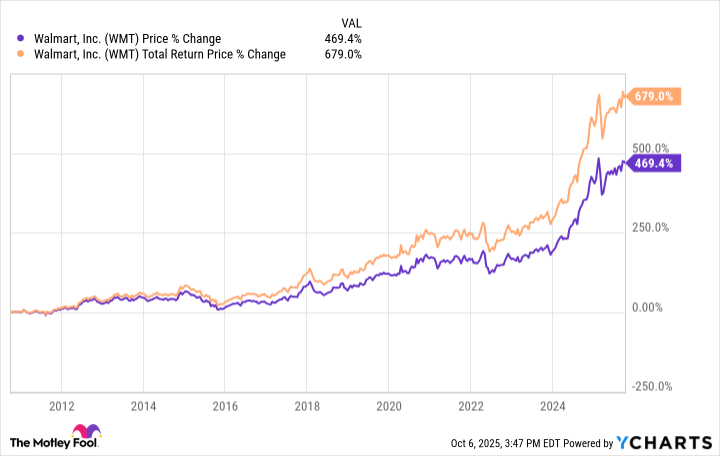In 2018, tech giant Apple became the first U.S. company to reach a market capitalization of $1 trillion. Since then, it's been joined by other companies such as Microsoft, Amazon, Alphabet, Meta Platforms, and Tesla. Of course, the list also includes the current market-cap leader, Nvidia.
It's becoming increasingly normal for a new company to join the $1 trillion club. But it remains an impressive feat nevertheless. At this pace, these tech titans could be joined by brick-and-mortar giant Walmart (WMT 0.10%) in 2026.
Over the past 15 years, Walmart stock has risen by 470%. The company has also been a steady dividend payer over this time. For investors who bought, held, and reinvested the dividends along the way, returns were even better with a 680% gain.
Stocks that post strong long-term gains, as Walmart stock has, often decide to undergo stock splits, bringing the price per share down due to a higher number of shares overall. Walmart has done this many times in its history, including a 3-for-1 stock split in 2024.
As of this writing, Walmart has a market cap of $820 billion. Therefore, to reach $1 trillion in 2026, it would need to appreciate by about 22% in less than 15 months. Is this really possible? It's not a sure thing, but it may be easier than some investors think.
How Walmart can reach $1 trillion
At a high level, stocks tend to go up when profit potential goes up. Perhaps profit potential goes up because a business is about to reach a new scale thanks to new locations or an acquisition. Or perhaps profit potential goes up because management is about to unlock some operating leverage. But either way, for Walmart stock to go up another 22%, one would expect improvement to its operating income over the next year or so.
Walmart is known for selling millions of products. But retail sales aren't driving growth for the company's operating income. In the earnings call to discuss financial results for its fiscal second quarter of 2026, CFO John Rainey said: "Contributions to operating income are increasingly influenced by a diverse set of interrelated drivers, including improved e-commerce, economics, and business mix, most notably from higher margin areas like advertising and membership fees."
Rainey attributes much of Walmart's operating income growth to e-commerce, an area of the business that's absolutely booming. In Q2, e-commerce revenue was up a strong 25% year over year globally, far outpacing the company's overall revenue growth of about 5%. If e-commerce continues to boom in 2026, it could drive operating income, and the stock price, higher.
Walmart's e-commerce growth provides it with another opportunity: Digital advertising. The company has troves of consumer shopping data and strong relationships with top consumer brands. With more customers transacting digitally, it gives the retailer an opportunity to generate high-margin digital advertising revenue.
Additionally, Walmart recently completed its acquisition of connected-TV company Vizio. This is another channel with which the company can leverage its data and scale to advertise to consumers, which again drives operating income growth.
For what it's worth, Walmart's Q2 advertising revenue was up 46%. Granted, some of the growth was inorganic from the recent addition of Vizio. But the company is growing this revenue stream nonetheless.
In other words, Walmart's fastest-growing revenue streams also happen to be the ones that are driving growth in operating profit. Assuming these trends continue, which I do, Walmart's profits should continue to climb in 2026, providing a boost for the stock price.
To be clear, Walmart might not grow enough over the next 15 months to warrant a $1 trillion valuation before the end of 2026. But directionally, the business appears to be headed for the trillion-dollar club. It doesn't seem to be a matter of if, but rather of when.






